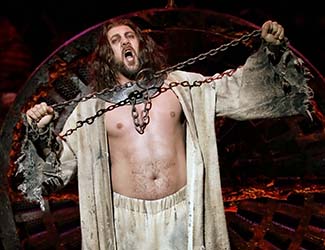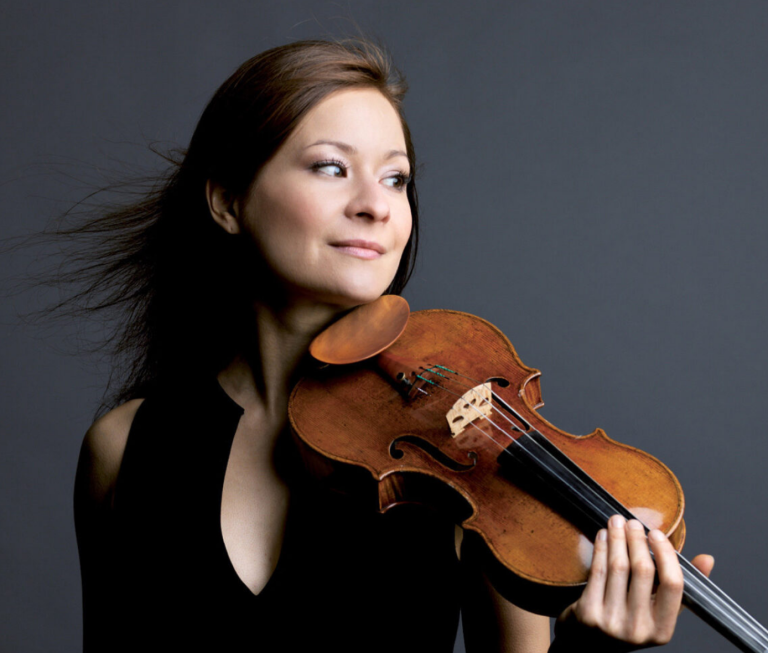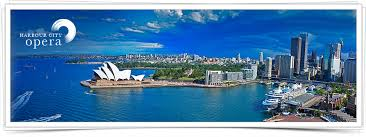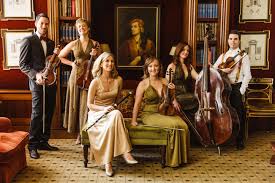Opera Review: Salome/Opera Australia
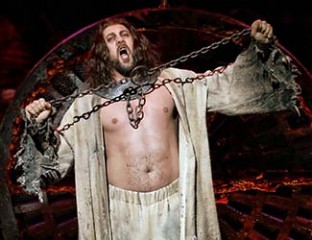
Photo credit: Prudence Upton
Salome – Richard Strauss
Opera Australia
Joan Sutherland Theatre, Sydney Opera House
6 March 2019
If Richard Strauss’ Salome were a movie, it may well display an X rating. Incest, necrophilia, lust, decapitation and suicide are all notorious elements in this, the third of Strauss’ operas and the one which made his name.
Opera Australia’s revival by Andy Morton of Gale Edwards’ take on the ancient tale, last seen in Sydney in 2012, is a welcome reprise, led by a luxury cast with Lise Lindstrom in the title role, Alexander Krasnov as Jokanaan, Andreas Conrad as Herod and Paul O’Neill as Narrabot. Jacqui Dark, Sian Pendry and Johannes Fritzsch return as Herodias, the Page/Slave and conductor.
Based on the 1891 play by Oscar Wilde and translated by Hedwig Lachmann, the tale is straight out of the Bible and set c AD 30. The New Testament books of St Matthew and St Mark describe Salome as the daughter of Herodias who dances for Herod on his birthday. So tantalised is Herod, that he promises the nymphette anything she desires. Coached by her mother, Salome demands the head of John the Baptist – Jokanaan, for whom she entertains a morbid infatuation. Spurned by him she eventually realises her obsession of kissing his lips – albeit they are now part of a head without a body.
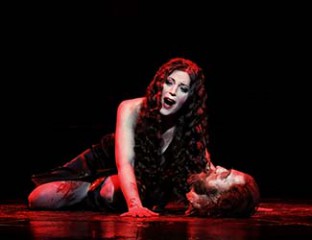
Lise Lindstrom as Salome in Opera Australia’s 2019 production of Salome at the Sydney Opera House. Photo credit: Prudence Upton
Wilde wrote the play for Sarah Bernhardt, who in the end, never performed it. Strauss first encountered a copy of the play in 1902. Unimpressed until he saw it performed in Berlin a few months later, he set to work on creating the opera which premiered in Dresden in 1905, earning 38 curtain calls! Despite its immorality attracting fractured reviews, it became popular in Germany. In Austria and Italy it was relegated to minor houses in Turin and Graz where it was seen by Mahler, Berg and Schoenberg amongst others. It was 1918 before it would be seen in Catholic Vienna where it was banned. Mahler had no opportunity to conduct it during his tenure at the Vienna State Opera, despite describing it as “one of the most important works of our day.”
New York’s Metropolitan opera premiered Salome in 1907, with the following review in the New York Tribune: “…Many faces were white…. its final horror left the listeners staring at each other with startling eyeballs and wrecked nerves.” Not surprisingly it disappeared from the repertoire for some 25 years.
London took it up in 1910, conducted by Sir Thomas Beecham under the Lord Chamberlain’s demand that all Biblical references be omitted. The setting moved to Greece and John the Baptist was given another identity as a prophet.
Why, when the Biblical story had been around for millennia and the play for decades, was the public reaction to the opera so extreme? Richard Strauss’ magnificent score surely played no small part in this awakening. Strauss is reputed to have said to his Prague orchestra “We want wild beasts here! This is not civilized music; it is music that must crash!” His music expressed the violence and depravity of the opera as well as breaking ground in style and orchestration.
Opera Australia’s production is supremely well presented by the cast and orchestra and is and all the more vivid for Julie Lynch’s frightful yet parodying costumes, Brian Thomson’s blood-red single set design and John Rayment’s narrative lighting.
Strauss’ expectation of a ‘16-year-old princess with the voice of an Isolde’ for the role of Salome was wildly optimistic, but Lise Lindstrom met its exacting demands with power, beauty and credible physicality. She moved from petulant teenager as she rejected Herod’s advances, to her “obstinato” young woman, insisting she will have her way as she asserts Ich will dein mund kussen, Jochanaan (I will kiss your lips Jokanaan) finally realising her ghastly sexual desire. Lindstrom’s Liebestod in the last moments of the opera was a tour de force.
Jokanaan was powerfully portrayed by Alexander Krasnov, his voice rising with rock-like faith expressing diatonic simplicity amongst the surrounding clashes. Emerging from his hideous confinement he conveys the noble hope of a higher purpose and a better place. Andreas Conrad was the amoral Herod unable to contain his desires; Jacqui Dark was perfection as Herodias. OA’s ensemble of seven male voices (Virgilio Marino, David Parkin, Christopher Hillier, Brad Cooper, Benjamin Rasheed, Andrew Moran and Tomas Dalton covering for John Longmuir) had a brief moment of brilliant cacophony. Their representation as a 21st century multi-faith synod, is a stroke of genius, which, like Edwards’ interpretation of the Dance of the Seven Veils, brings some contemporary relevance to this most ancient of stories.
Despite Strauss’ specifications for his female lead, there are few who can sing the role yet dance the often cliched “Seven Veils” with the requisite ability, grace and sensuality. Gale Edwards’ avoids this dilemma and cleverly uses the Dance of the Seven Veils to portray seven personifications of women through time.
Johannes Fritzsch mustered a 70 strong-orchestra (originally 105) which played this continuous operatic tone-poem, lurching from one black key to another in a thrilling range of colours and deftly expressing the various leitmotifs. The clarinet howls Salome’s opening obsession theme as the talk turns to the moon, Jokanaan’s motif is radiant and hymn-like; the Prophecy motif shimmers yet niggles; Salome’s Kiss motif is stubborn; the double-bass figure during the execution becomes one of the most tense moments in all opera. So accomplished was the orchestra that they dominated the opening scenes – take away an overture and this is what happens! The balance between voices and instruments was soon restored as the singers warmed up and the major characters appeared.
This production of Salome features a superlative cast and is a production that has integrity and credibility. It is also worth experiencing for Strauss’ incomparable musical writing. Historically it is quoted to be an exemplar of fin-de-siecle innovation. It was the time of discovery – of sexuality, of the exotic East and of new expressions in music. It is no coincidence that Sigmund Freud (1856 – 1939) published his Three Essays on the Theory of Sexuality, in the same year of the opera’s premiere. His Interpretation of Dreams preceded it in 1899.
Capital entertainment.
Shamistha de Soysa for SoundsLikeSydney©
Salome is on in the Joan Sutherland Theatre of the Sydney opera House on selected evenings till March 26 with a matinee on March 23.

